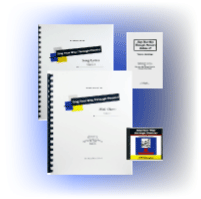





Contractions Lesson Plan
Contraction Action
- Students will learn to read and spell common contractions formed from a verb paired with the word not.
(Ex. do + not = don’t) - Students will learn to read and spell common contractions formed from a pronoun paired with a verb.
(Ex. I + am = I’m)
Contractions are formed by combining two words and replacing one or more of the medial letters with an apostrophe. Once students have mastered the basic words in the song, they can think of other examples of diphthong words and practice them with the instrumental version of the song. Many contractions are formed when the word not follows a verb of being like is, are, was, or were. The basic song provides practice in forming these types of contractions by combining the two words and replacing the letter o with an apostrophe. Using instrumental version of the song with Mini-Chart templates of self-made flashcards, students can practice forming other types of contractions such as she’ll, we’d, or I’m. Step 7 of the lesson plan Follow-Up below provides alternate words for use with these other types of contractions.
- Sing Your Way Through Phonics Volume 2 CD, Tracks 17 and 18 (Listen to audio sample)
- Sing Your Way Through Phonics Volume 2 Mini-Charts (pp. 73-84)
- Index cards with the following words: did, do, is, are, could, would, will, not (10 copies), wo (word fragment), can
- Optional:
- Index cards he, she, we, they, you, I, have
- Create apostrophe sticky notes in varying widths sufficient to cover 1, 2, 3, and 4 letters.
- With black marker, draw an apostrophe in the center of each sticky note.
- Make 10 copies of each size.
Note: If you do not have the CD or Mini-Charts, you can still teach this contractions lesson plan using the folk tune listed on the Contraction Action Song Lyrics page. You can create your own mini-charts using the words in bold print letters in each verse of the Song Lyrics.
Find out more about Sing Your Way Through Phonics products.
Order our cost-saving Volume 2 Combo online.

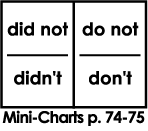


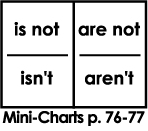
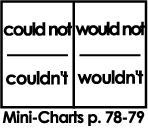
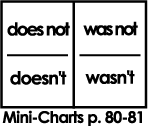
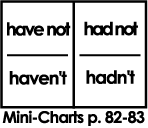

- Say, “Does anyone know what the word contract means?” (to shorten or make smaller) Today, we will be looking at what happens when we combine two words and contract them into one smaller word. We call these shortened words contractions because the one combined word uses fewer letters than the two separate words.”
- Point to the Mini-Charts on pages 74-75. As a group, read the two separate words at the top of the page and then read the contraction at the bottom of the page. Ask, “What did we leave out when the two words were pushed together?” (the letter o) Ask, “And what did we add in place of the letter o?” (an apostrophe)
- Place the cards with the words did and not on the chalk ledge. Place the narrowest apostrophe sticky note on the chalkboard nearby.
- Ask, “Who can combine these two words into the word didn’t?” (A student pushes the two words together and covers the letter o with the apostrophe sticky note.)
- Repeat Steps 3 and 4 with the words do and not, forming the contraction don’t.
- Listen to Contraction Action on CD Track 17, pointing to the target words on Mini-Charts pp. 74-84. Ask the students to join in on the part of the song that repeats the contraction spelling rules. (“Just put ’em together and leave out the o. That is where the apostrophe goes, and contraction action ever goes marching on.”)
- Ask, “What two words did not follow the contraction rule?” (will and not) Say, “Before we can put these two words together, what did we have to change?” (will to wo)
- Place the cards with will and not on the chalk ledge. A small distance away, place the fragment wo on the chalk ledge. Place all four sizes of sticky notes on the chalkboard.
- Ask, “Who can show the way the song tells us to form the word won’t?” (Push cards with will and not together, replace will with wo, and place the apostrophe sticky note over the o.)
- Go over the words to the exception in the song. (The one exception to this rule is won’t. Unlike the others, change will to wo. It rhymes with don’t.)
- Sing the song with CD Track 17 again and allow students to point to the target words on the Mini-Charts. One student can stand to the left of the charts and another can stand on the right. The person on the right also turns the pages when needed.
- Repeat Steps 3 and 4 with the words is + not, are + not, could + not, would + not, does + not, was + not, have + not, and had + not.
- Explain that there is another common contraction that we can from from the words can and not. Say, “What is the single word for can and not? Instead of saying I can not go, we can say I _____ go.” (can’t)
- Say, “Who can form the contraction from these two words?” (Push can and not together. Replace the letters n and o with apostrophe. Use the 2-letter wide sticky note.)
- Say, “What was different this time?” (We left out the letter n as well as the letter o and replaced them both with an apostrophe.)
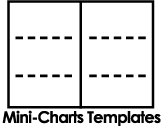
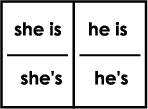
- Practice singing Contraction Action daily for a few days. Allow some of the students to be the leaders, pointing to the Mini-Chart words.
- Introduce other contraction words. (See Optional Materials above.) Using the word cards and apostrophe sticky notes, form the contractions he’s (he + is) and she’s (she + is). Discuss the fact that this time, the letter i is left out and replaced with an apostrophe.
- Now form the words we’re (we + are), you’re (you + are), and they’re (they + are). Discuss the fact that this time, the letter a is left out and replaced with an apostrophe).
- Using the word cards, form the words I’d (I + would), we’d (we + would), you’d (you + would), and they’d (they + would). Discuss the fact that this time, four letters are replaced with an apostrophe. Use the widest apostrophe sticky notes. Repeat with the words she’d and he’d.
- Using the word cards, form the words I’ve (I + have), we’ve (we + have), you’ve (you + have), and they’ve (they + have). Discuss the fact that this time, two letters are replaced with an apostrophe. Use the second widest apostrophe sticky note.
- Using the word cards, form the words I’ll (I + will), you’ll (you + will), we’ll (we + will), he’ll (he + will), she’ll (she + will), they’ll (they + will). Discuss the fact that this time, the letters w and i are replaced with an apostrophe.
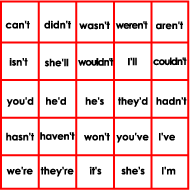
- Play a Bingo spelling game in which the caller states two words and the players remove the squares with the corresponding contraction. Print contractions on a 6 x 6 grid. Students cut apart the grid and place selected squares on a 5 x 5 grid. The first player with 5 empty squares in a row wins.
- Read books with contractions: Polly Cameron’s I Can’t Said the Ant and Jack Prelutsky’s I’d Never Dine on Dinosaurs, I’m a Basic Boneless Chicken, I’d Never Eat a Beet, Ma, Don’t Throw That Shirt Out! and My Mother Says I’m Sickening (from The New Kid on the Block).
- Duplicate the Mini-Chart templates on page 102 and write some of these other contraction examples. Using the instrumental version on CD Track 18, sing the song with the following words:
When ____ ____ becomes a single word, it’s ___, it’s ___.
When ____ ____ becomes a single word, it’s ___, it’s ___.
Save only the final letters, you see.
Replace the rest with apostrophe
And contraction action ever goes marching on
- Students read all the words on Mini-Charts pp. 74-84.
- Students pass a spelling test on all Mini-Chart words and class-generated examples.
- Students spell contraction words correctly in their journals and other writing assignments.
